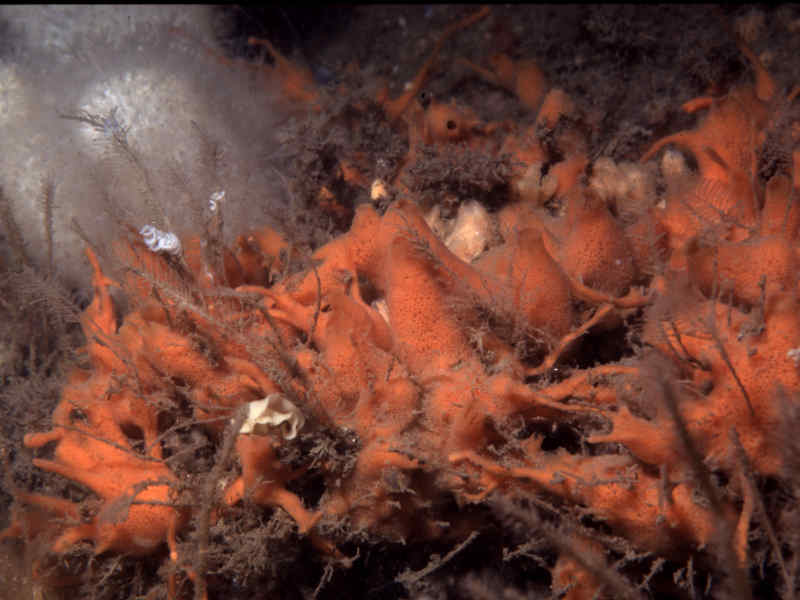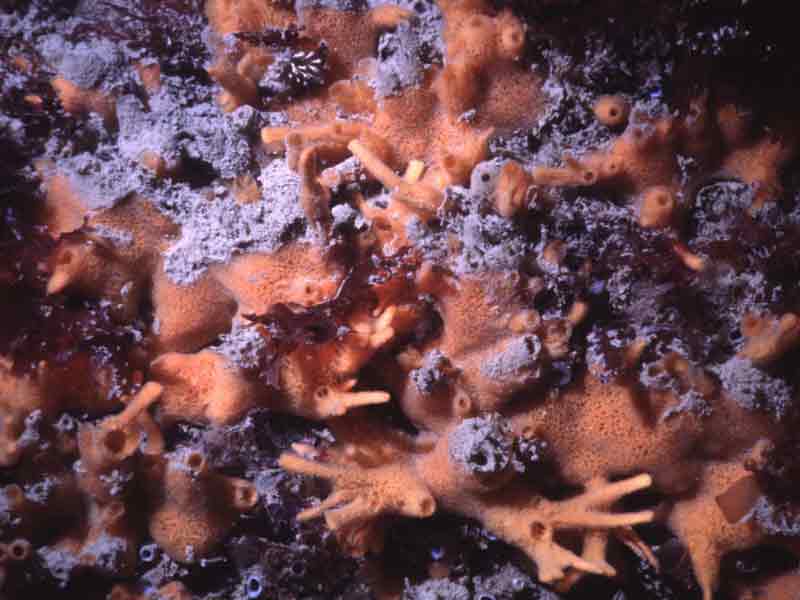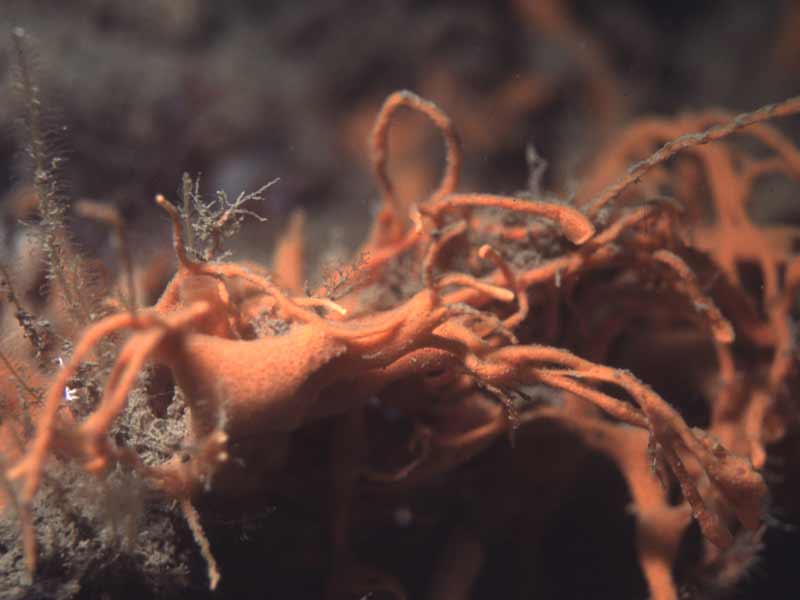Shredded carrot sponge (Amphilectus fucorum)
Distribution data supplied by the Ocean Biodiversity Information System (OBIS). To interrogate UK data visit the NBN Atlas.Map Help
| Researched by | Edward Mayhew | Refereed by | Admin |
| Authority | (Esper, 1794) | ||
| Other common names | - | Synonyms | Amphilectus fucorum , Amphilectus fucorum (Esper, 1794), Esperiopsis fucorum |
Summary
Description
An intense reddish orange encrusting soft sponge, which becomes colourless in alcohol. The body shape is highly variable amongst individuals (extremely polymorphic) and individuals are fast growing, changing shape within a few weeks. It can form thin sheets, cushions, or massive, lobose or branched structures. The sponge can also occur in hollow 'amphora' shaped forms in sheltered conditions.
Recorded distribution in Britain and Ireland
Recorded from the Shetland Isles, Orkney, Fraserburgh, the Firth of Forth, Northumberland and east Yorkshire, the southeast, south and southwest coasts of England, the west coasts of England and Scotland, and all coasts of Ireland.
Global distribution
Recorded on the Atlantic coasts of Europe from Norway and the Faeroe Islands to the Mediterranean.
Habitat
It occurs in the shallow sublittoral zone, often overgrowing the holdfasts of Laminaria sp. or sessile invertebrates. It can tolerate a wide range of exposures and can also be found in areas experiencing strong tidal currents. Occasionally found in cryptic low-littoral habitats.
Depth range
-Identifying features
- Encrusting or creeping branching soft sponge.
- Soft, delicate and very flexible consistency, with slight contraction.
- Massive-lobose (vertical growth results in lobed forms, lateral growth results in ridged forms), thin sheets, cushions or branched forms.
- Size variation from 2 cm to 15 cm high.
- Non-contracting oscules only slightly raised from the surface, or at the top of volcano-like growths.
- May have tassel growths originating from the oscule margins.
- Branching form individuals are often arranged in linear series.
- Sponge surface is even, with moderate friction and fairly open in appearance.
- Subectosomal tissue is peppered with pore channels which are covered with a thin transparent layer.
- Has a characteristic and strong odour.
- Megasclere spicules are smooth and usually curved.
- Microsclere spicules are small and have ends which bear shovel-shaped structures (isochela).
Additional information
The pigment can be squeezed out between the fingers. The sponge is thought to go colourless in deeper water. It has also been found growing up hydroid stems.
Listed by
- none -
Bibliography
Hayward, P.J. & Ryland, J.S. (ed.) 1995b. Handbook of the marine fauna of North-West Europe. Oxford: Oxford University Press.
Hooper, J.N.A. & Van Soest, R.W.M., 2002. Systema Porifera: A guide to the classification of sponges. Volume 1 & 2. New York: Kluwer Academic/ Plenum Publishers.
Howson, C.M. & Picton, B.E., 1997. The species directory of the marine fauna and flora of the British Isles and surrounding seas. Belfast: Ulster Museum. [Ulster Museum publication, no. 276.]
JNCC (Joint Nature Conservation Committee), 1999. Marine Environment Resource Mapping And Information Database (MERMAID): Marine Nature Conservation Review Survey Database. [on-line] http://www.jncc.gov.uk/mermaid
Moss, D., & Ackers, G. (eds.), 1982. The UCS Sponge Guide. Produced by R. Earll. Ross-on-Wye: The Underwater Conservation Society.
Stachowitsch, M., 1992. The invertebrates: an illustrated glossary. USA: Wiley-Liss.
Van Soest, R.W.M., Picton, B. & Morrow, C., 2000. Sponges of the North East Atlantic. [CD-ROM] Windows version 1.0. Amsterdam: Biodiversity Center of ETI, Multimedia Interactive Software. [World Biodiversity Database CD-ROM Series.]
Datasets
Centre for Environmental Data and Recording, 2018. Ulster Museum Marine Surveys of Northern Ireland Coastal Waters. Occurrence dataset https://www.nmni.com/CEDaR/CEDaR-Centre-for-Environmental-Data-and-Recording.aspx accessed via NBNAtlas.org on 2018-09-25.
Fenwick, 2018. Aphotomarine. Occurrence dataset http://www.aphotomarine.com/index.html Accessed via NBNAtlas.org on 2018-10-01
Kent Wildlife Trust, 2018. Kent Wildlife Trust Shoresearch Intertidal Survey 2004 onwards. Occurrence dataset: https://www.kentwildlifetrust.org.uk/ accessed via NBNAtlas.org on 2018-10-01.
Manx Biological Recording Partnership, 2022. Isle of Man historical wildlife records 1990 to 1994. Occurrence dataset:https://doi.org/10.15468/aru16v accessed via GBIF.org on 2024-09-27.
Merseyside BioBank., 2018. Merseyside BioBank (unverified). Occurrence dataset: https://doi.org/10.15468/iou2ld accessed via GBIF.org on 2018-10-01.
National Trust, 2017. National Trust Species Records. Occurrence dataset: https://doi.org/10.15468/opc6g1 accessed via GBIF.org on 2018-10-01.
NBN (National Biodiversity Network) Atlas. Available from: https://www.nbnatlas.org.
Norfolk Biodiversity Information Service, 2017. NBIS Records to December 2016. Occurrence dataset: https://doi.org/10.15468/jca5lo accessed via GBIF.org on 2018-10-01.
OBIS (Ocean Biodiversity Information System), 2025. Global map of species distribution using gridded data. Available from: Ocean Biogeographic Information System. www.iobis.org. Accessed: 2025-07-21
South East Wales Biodiversity Records Centre, 2023. SEWBReC Marine and other Aquatic Invertebrates (South East Wales). Occurrence dataset:https://doi.org/10.15468/zxy1n6 accessed via GBIF.org on 2024-09-27.
Citation
This review can be cited as:
Last Updated: 29/07/2004





